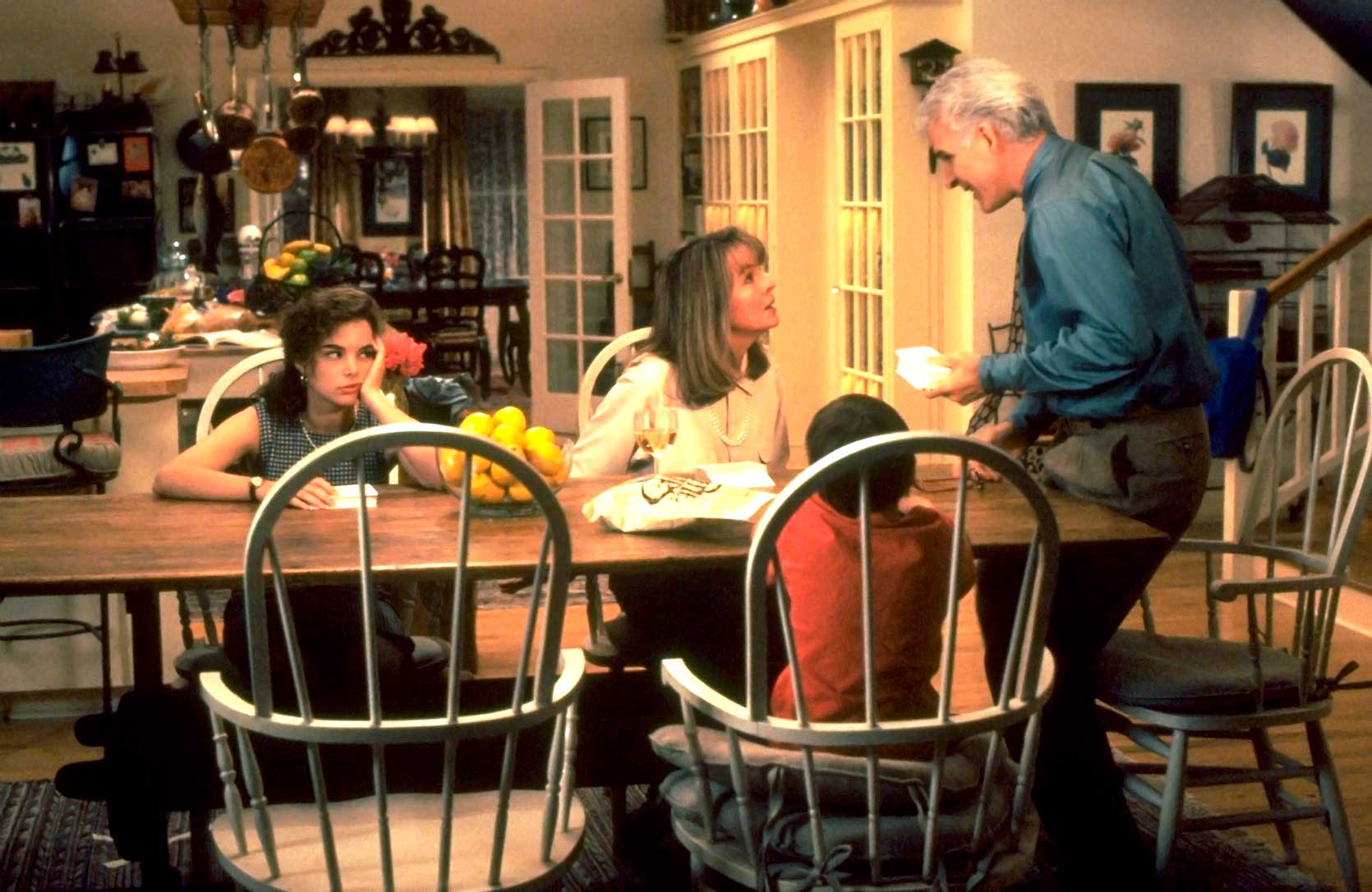When I first moved from my mid-city LA apartment out east to the Pasadena area, the first thing my mother asked me was “How far are you from the Father of the Bride house?!?!?” The 1991 movie that was set in the nearby town of San Marino (though it was filmed in Pasadena) has been a main character in my family’s life basically since it hit the silver screen. Before I knew anything about design, before I knew the name Nancy Meyers (who co-wrote FotB), heck, before I even turned double digits, I knew that the house from the film my mother constantly proclaimed as her favorite was aspirational, to say the least.
I can’t recall if we ever spoke of the interiors specifically, but the exterior was “dream home” status for my momma, and she compared everything to it. I grew up in a Colonial with wood siding and a front porch, and even though it didn’t *actually* look like the Banks residence, we kind of pretended like it did. We had hunter green shutters flanking all of the front windows; there was a big oak tree out front (that eventually came down after a treacherous hurricane); and the soft yellow my parents picked when they repainted in the ‘90s sort of, kind of emulated the creamy, buttery white on the famous house’s exterior (if you squinted). Let’s be real, though, no one was going to mistake our middle-class Central Florida home for it, but it made us happy, nonetheless.
And that’s the thing about the set design from all my favorite movies with the Nancy Meyers name attached to it: they just make you happy. Sure, the characters are great, and the script is warm and fun and sweet, but it’s the interiors of all the homes these stories take place in that leave the biggest mark.

Before sitting down to write this, I challenged myself to just stream-of-consciousness journal what came to mind when I thought of Meryl Streep’s kitchen in It’s Complicated, or Diane Keaton’s Hamptons home in Something’s Gotta Give. Oh and don’t get me started on just EVERYTHING in the Lindsay Lohan version of The Parent Trap. That ridiculously cozy cottage Kate Winslet’s character calls home in The Holiday? SHUT UP.
Here’s an (edited) version of what I came up with in bullet form to make it easier to follow (Jimmy Fallon does a good job of also summarizing the vibe in this hilarious music video):
- Nancy Meyers interiors are less about the specific design and more about how they leave you feeling. You don’t necessarily remember the furniture or the paint color, but you can recall that you want in on that life.
- Looks like how a farmer’s market makes you feel ← (still think this is the best descriptor)
- Like you’re the type of person who eats pan-toasted sourdough with a smear of plum preserves every morning for breakfast awash in a soft glow of morning light. You definitely drink coffee out of a French press.
- Like fancy granola from a specialty food market in a clear plastic bag with a pretty ribbon tied around it ← (I’m not sure where I was going with this but it’s somehow evocative, right?)
- Laidback, understated, comfortable, well-worn, layered
- What “coming home” should feel like
- Ease of styling, nothing is perfectly styled
- Rooms have a mix of both functional and pretty things (especially the kitchens)
- Warm in the winter, cool in the summer ← (an actual line from Father of the Bride)
- Not afraid of clutter/layering
- Sophisticated ease. Pulled together but a tiny bit quirky but also comfortable and warm
- Casual and coastal without being beachy
- Chintz?
- Gingham!
- Canisters full of grains ← (by this point I got around to referencing specific things my brain remembers seeing…more on that in a bit)
If my list is any indication, these are homes that are lived in. A place where someone actually sits in the corner chair and devours a novel. A kitchen where croissants and summer-harvested fruit jams are whipped up. Books are stacked in corners and on bookshelves without worrying about what just right object can be bought to style a curated selection of coffee table books no one has ever read. They are personal to the characters living in them, and feel so real (even though they’re fake).

It’s giving “I’m rich, but humble” and “Yes, I hired a decorator but want people to think I did this myself.” And I think that’s what we all love about it. Jon Hutman and Beth Rubino, two of Nancy’s go-to production designers, have figured out a way to create rooms that are nostalgic without being dated. Layered without being cluttered (well, it depends on who you are, I guess). Whoever lives in these rooms cares nothing about being “cool” because the rooms aren’t cool. What they are is welcoming, inviting, and just designed enough. And while yes, these are spaces created for movie characters with obvious wealth, they’re still packaged up to feel relatable and warm, almost as if you too might someday find your secret twin sister and swap your Napa ranch for her enormous London estate.
Don your white cashmere head-to-toe outfit kids and let’s dive deeper, shall we?

Nancy Meyers…Two Ways
I’d be lying if I said I was the first person to ever write an article about my devotion to Nancy Meyers interiors and how they make me feel. The internet is chockful of them. Just Google “Nancy Meyers aesthetic” and you’ll be scrolling endlessly. In fact, I’m not certain there’s a bottom to that search engine bucket. I’ve seen many interpretations in my day of what comprises this look and each article really focuses on one aspect of the style. Really, though, there are (at least) two: the “coastal grandma” casual beachy neutral aesthetic and the “pastoral grandma” casual English mixed with French country vibe.
Either way, I think it’s safe to say that the foundation for any Nancy Meyers-inspired room is warm neutrals and just tons of fabric (be it in curtains, pillows, throws, rugs, slipcovers, etc.). And candles. So. Many. Candles. And white lampshades with warm lightbulbs always turned on.

But there are not-so-subtle differences between both of the styles I outlined above. One is decidedly more frilly and layered and chintzy (Father of the Bride, the cottage from The Holiday, the London home in The Parent Trap). The other is quieter and calmer but still just as inviting (It’s Complicated, Something’s Gotta Give, the Los Angeles home in The Holiday, the Napa ranch in The Parent Trap). I guess it depends on where the female lead lives…is it more Santa Barbara or Southampton? Surrey or San Marino? Napa or London? (Who cares, I’ll take one of each.)
I did the lord’s work and went back and scanned through all of my favorite movies while I was down with the flu recently, and took stock of living rooms, bedrooms, kitchens, and dining rooms. I grabbed screenshots and then collaged them together to get the full scope of everything side by side.
The Nancy Meyers Kitchen

Analysis: Lots of stuff. Bowls of lemons and oranges. Always copper pots hanging from a rack. White or chalky blue cabinets. Crocks and canisters and organized matching spice jars.
The Nancy Meyers Living Room

Analysis: Slipcovered sofas and fireplaces and chairs big enough for curling up and reading and lots of linen and cotton canvas and stripes and floral pillows and lamps, lamps, lamps.
The Nancy Meyers Dining Room

Analysis: Candlesticks and taper candles and toile upholstered chairs and dark mahogany and warm lighting and ladder back chairs. Some layered window coverings and white dinnerware.
The Nancy Meyers Bedroom

Analysis: Either upholstered beds or metal spindle, more soft lighting, vintage nightstands or trunks and, of course, all. the. quilts.
As I’m nothing if not thorough, I compiled the “recipe” for each look below like I was assigned a book (movie) report on the production design. Here is what my summary would look like:

Clearly, plenty of crossover, but the differences are more obvious with visuals. Let’s examine two moodboards I put together using my summary of both NM styles as a guide. In truth, I could have made moodboards for every room of the house in each of these aesthetics, but this post is already long enough.

How to Get the Nancy Meyers Aesthetic In Your Home
First up is the “coastal grandma” wing of Nancy Meyers interiors. I studied my screenshots to pull specific elements that I think all work together for the more casual, streamlined look. Of course, there’s the slipcover sofa, but I also noticed a lot of upholstered ottomans, and most of the armchairs were either a solid linen or canvas, or a subtle pinstripe. I opted for larger pillar candles and clear hurricane vases over tapers and candlesticks because it felt more “Meryl Streep in Santa Barbara.” I also quickly noticed that there were no light wood tones in sight, which I showcased below through the mahogany-finished chest of drawers. Rugs are almost always sisal or an Annie Selke-like stripe, and the quilts, while present, aren’t overly in your face. A smattering of Delft chintz via pillows is ever-present, as are elements like copper pots and white empire lamp shades.

Armchair | Ottoman | Sofa | Copper Pots | Hanging Rack | Hurricane Vessels | Table Lamp | Bed | Quilt | Throw Pillow | Chest of Drawers | Rug
On to the more layered design. Many of the elements are the same, just tweaked. The sofa is still traditional, casual and slipcovered, but the armchair has a more obvious print and pattern (I went back and forth between this blue striped option and a floral but landed here as to not go overboard). The rugs are subtle but vintage; there’s plenty of warm lighting via candles and lamps but things are skinnier and more classic. Nancy clearly has a thing for metal spindle beds in white and silver tones, which read charming cottagecore, for sure. It’s hard to not notice lots of botanical prints on the walls of the houses in the movies, and the same goes for Windsor-style dining chairs. As for the textiles, there are no obvious rules followed for pattern matching; almost as if the person living in the home just bought what they liked and that is the sole reason they go together. Quilts are almost always patchwork, and pillows are always floral.

Armchair | Trunk | Sofa | Copper Pots | Hanging Rack | Candlesticks | Table Lamp | Bed | Quilt | Throw Pillow | Art Prints | Dining Chair | Rug
The interesting thing about having gone through this deep dive exercise into an aesthetic I hold so close to my heart is that I don’t think I’d actually put any of my rooms together to look like this. I’d love to take a few weeks in the summer or winter and hunker down in a home that looks like this, sure. Make all the jam and squeeze all the fresh orange juice and have all the dinner parties, but my personal style tends to be more streamlined yet colorful. I know this because I recently swapped out my beautiful pinstripe linen duvet cover for a slate blue and white gingham percale cover, and while it sleeps like a dream, I’m not in love with it visually. I’m tempted to Nancy Meyers it up to make it work, but I also kind of think I’m better off admiring the warmth and elegance through my TV screen rather than in my actual home.
That’s the fun of design. You can mentally try on a lot of looks, dream about what it would be like to spend time in spaces that aren’t yours, maybe take a little inspiration and sprinkle it throughout, but you don’t have to go all in. Or you totally can. Whatever makes you as happy as a Nancy Meyers movie makes me.
Until next time, friends…
Opening image credit: It’s Complicated, 2009. ph: Melinda Sue Gordon / ©Universal / Courtesy Everett Collection
THIS POST WAS ORIGINALLY PUBLISHED HERE.


